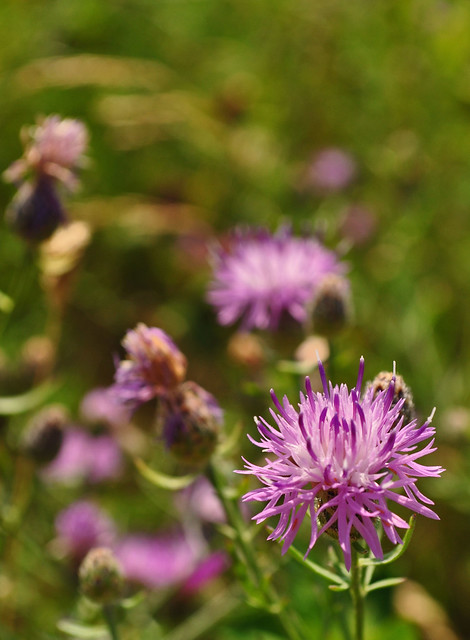During our camping trip last month to
Lake Sherando we had time to explore the nearby
Blue Ridge Parkway. Today the area is heavily forested, but at the turn of the last century most of the mountains were denuded of trees and being used for pastureland and apple orchards. There are still a few remnants maintained as meadows, and one of those is the Big Spy Mountain Overlook. It's a place I usually stop, not so much for the view, but for a chance to wonder through the small meadow. On this trip I found it full of wildflowers, and the place was abuzz with insect activity. It was also abuzz with people activity. A caravan had pulled up just before we got there, and the occupants found themselves suddenly able to receive signals for their smart phones after seemingly going sometime without. It was comical watching husbands, wives and children all checking email, calling contacts and texting. They acted like sailors, marooned on some desolate coast, boarding the rescue ship.
Anyway, when it comes to wildflowers, I usually have to do a little research to get a definite species name on a few. While I was in this process for the plants below I was baffled that I could not find two of them listed in any native plant references. Expanding my search I found the unknowns listed as invasives of European origin. Judging from their numbers at the overlook, they are very happy in their new home and seem to get along with the older neighbors, at least at this point.
Centaurea maculosa (Spotted Knapweed, non-native)
 Centaurea maculosa
Centaurea maculosa and
Daucus carota (Queen Anne's Lace, non-native)
 Tragopogon dubius
Tragopogon dubius (Western Salsify, non-native)

 Monarda fistulosa
Monarda fistulosa (Beebalm, native)
 Asclepias syriaca
Asclepias syriaca (Common Milkweed, native)

 Rudbeckia fulgida
Rudbeckia fulgida (Black-eyed Susan, native)

Hopefully if I have missed an ID, someone out there will let me know.








Pretty natives.
ReplyDeleteI like meadows full of wildflowers.
ReplyDeleteFabulous to see Rudbekia fulgida growing as nature intended - and happy to see that we have managed to donate some pretty non-natives that play well with others! Gorgeous shots. I love meadows in full flower, wonderfully diverse.
ReplyDeleteBeautiful pics. It is hard to believe that we ever lived or survived without cell phones or email. So many people can hardly go a few minutes without checking their phone. Its nice to be disconnected and enjoy the world around us, I think.
ReplyDeleteOoooo....purple flowers in a meadow....great pics!!
ReplyDeleteJeg kom lige forbi din blog.
ReplyDeleteGode billeder. Rigtig mange smukke blomster.
Tak for kigget.
first it was the telephone, cell phone, fax machine, computer, email, texting, social network, What next? video calls?(have that). Mind control.....
ReplyDeleteKnapweed and Queen Ann's Lace are both noxious in most states.
Nice photos and post.
My favorite part of living out here is being close to the Parkway!
ReplyDeleteLooks like a nice meadow. I was intrigued by the Centaurea because we grow the similar looking Centaurea dealbata. After reading about the way Centaurea maculosa limits it's neighbors I think we'll stick with the C. dealbata.
ReplyDelete